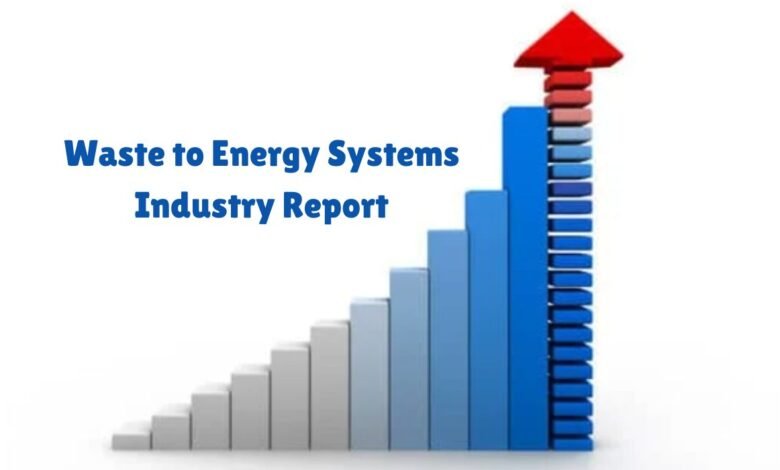Waste to Energy Systems Industry Report
Waste to Energy Systems Industry Report: In-depth analysis, trends, market growth, and future opportunities in converting waste into energy.

Waste to Energy (WtE) systems are innovative technologies designed to convert municipal solid waste into usable forms of energy, such as electricity, heat, or fuel. These systems play a crucial role in modern waste management by addressing the dual challenges of waste disposal and energy production. The basic principle of WtE involves the thermal treatment of waste materials, which results in the generation of energy and the reduction of waste volume.
The concept of converting waste into energy is not entirely new. Historical records indicate that ancient civilizations utilized waste materials for energy purposes, albeit on a much smaller and less sophisticated scale. However, it was not until the 20th century that technological advancements enabled the development of modern WtE systems. These advancements have significantly improved the efficiency and environmental performance of WtE technologies.
As urbanization continues to accelerate and environmental concerns become more pressing, the need for sustainable waste management solutions has never been greater. Traditional waste disposal methods, such as landfilling and open burning, are increasingly seen as unsustainable due to their environmental impacts and space requirements. Landfills contribute to greenhouse gas emissions and pollution, while open burning releases harmful pollutants into the air.
WtE systems offer a viable alternative by transforming waste into renewable energy, thereby reducing the volume of waste that ends up in landfills. This process not only mitigates the environmental burden associated with waste disposal but also contributes to the generation of renewable energy. The energy produced from WtE plants can be fed into the power grid, providing a source of clean energy that supports the transition to a more sustainable energy mix.
Waste to Energy systems are an essential component of modern waste management and energy production strategies. By converting waste into valuable energy, these systems address critical environmental and energy challenges, making them a key player in the pursuit of sustainable development.
Current Market Trends and Developments
The waste to energy (WtE) industry has seen significant growth and transformation in recent years. As of 2023, the global market size for WtE systems is estimated at $35 billion, with a projected compound annual growth rate (CAGR) of 6.4% over the next five years. This growth is driven by increasing urbanization, stringent waste management regulations, and the rising need for sustainable energy solutions.
Key players in the WtE industry include Veolia, SUEZ, Covanta Energy, and Hitachi Zosen Inova. These companies are at the forefront of technological innovations, continually pushing the boundaries of what is possible in waste to energy conversion. Notable advancements in the industry include improvements in incineration technology, which have led to higher efficiency rates and reduced emissions. Gasification and anaerobic digestion are also gaining traction as viable alternatives to traditional incineration, offering cleaner and more efficient energy recovery methods.
Emerging markets are playing a crucial role in the expansion of the WtE industry. Regions such as Asia-Pacific, Latin America, and Africa are witnessing rapid adoption of WtE systems, driven by increasing waste generation and the need for sustainable waste management practices. In particular, countries like China and India are investing heavily in WtE infrastructure to address their growing waste management challenges.
- Global market size: $35 billion (2023)
- Projected CAGR: 6.4% (2023-2028)
- Key players: Veolia, SUEZ, Covanta Energy, Hitachi Zosen Inova
- Technological innovations: Advanced incineration, gasification, anaerobic digestion
- Emerging markets: Asia-Pacific, Latin America, Africa
Overall, the current trends and developments in the WtE industry indicate a promising future, with significant potential for growth and innovation. As technology continues to evolve and more regions adopt WtE systems, the industry is poised to play a vital role in global waste management and energy production strategies.
Benefits and Challenges of Waste to Energy Systems
Waste to Energy (WtE) systems present a multifaceted array of benefits that extend across environmental, economic, and social domains. One of the most prominent advantages of WtE systems is their contribution to reducing greenhouse gas emissions. By diverting waste from landfills and converting it into energy, these systems significantly lower the release of methane, a potent greenhouse gas. Moreover, WtE systems help conserve natural resources by reducing the need for fossil fuels, thereby promoting a more sustainable energy landscape.
Economically, WtE systems offer a reliable source of renewable energy, which can help stabilize energy prices and reduce dependency on imported energy resources. The creation of local jobs in the development, operation, and maintenance of WtE facilities also stimulates local economies. Socially, these systems can enhance community resilience by providing a consistent energy source and reducing the environmental impact of waste disposal.
However, the implementation of WtE systems is not without its challenges. One significant barrier is the high initial capital investment required to develop these facilities. The costs associated with advanced technology and infrastructure can be prohibitive, especially for smaller municipalities. Additionally, while modern WtE facilities are designed to minimize emissions, there is still a potential for air pollution. Concerns over the release of pollutants such as dioxins and heavy metals can lead to public opposition, further complicating project implementation.
Public perception also plays a crucial role in the success of WtE projects. Misconceptions about the environmental impact and safety of these systems can fuel resistance from communities. Effective communication and transparency, supported by expert opinions and case studies, are essential to address these concerns and build public trust.
Waste to Energy systems offer substantial benefits in terms of environmental sustainability, economic stability, and social well-being, addressing the challenges related to cost, potential emissions, and public perception is crucial for their widespread adoption and success.
- Payment Processor Market Projected to Gain Significant Value
- Business Owners Should Know About These 5 AI Tools
- The Top 6 Bookkeeping Software for Small Businesses and Freelancers
Future Outlook and Opportunities
The future of waste to energy (WtE) systems is poised for significant transformation, driven by technological advancements, evolving policies, and increased investments in sustainable practices. This sector offers substantial growth opportunities, promising to reshape how waste is managed and energy is produced. As we look ahead, several key trends and opportunities emerge that will likely shape the industry’s trajectory.
Firstly, advancements in technology are expected to enhance the efficiency and effectiveness of WtE systems. Innovations such as improved thermal conversion processes, advanced gasification techniques, and the integration of artificial intelligence for optimized operations are on the horizon. These advancements will not only increase the energy output but also minimize environmental impact, making WtE systems more attractive and viable.
Secondly, policy changes and government regulations will play a pivotal role in the future of WtE systems. Increased emphasis on reducing carbon emissions and managing waste sustainably is expected to drive supportive legislation. Governments worldwide are likely to introduce more stringent waste management policies and offer incentives for the adoption of WtE technologies. Such measures will create a favorable environment for the growth of this industry.
Investment in sustainable practices is another critical factor. With global attention on climate change and sustainability, there is a growing interest from both public and private sectors to invest in green technologies. WtE systems, being at the intersection of waste management and renewable energy, are well-positioned to attract significant funding. This influx of capital will enable the development and scaling of innovative WtE solutions.
Moreover, international agreements and collaborations will further bolster the WtE sector. Global initiatives aimed at achieving sustainability goals, such as the Paris Agreement, emphasize the importance of transitioning to renewable energy sources. WtE systems can contribute significantly to these targets by providing a renewable energy source while addressing waste management challenges.
Key opportunities and predictions for the future of WtE systems include:
- Enhanced efficiency and reduced emissions through technological innovation
- Supportive government policies and regulatory frameworks
- Increased investment from public and private sectors in sustainable WtE solutions
- Strengthened international cooperation to achieve global sustainability goals
- Growth in the deployment of WtE systems in urban and industrial areas
As the world moves towards a more sustainable future, WtE systems are set to play a crucial role in achieving global sustainability targets. By harnessing the potential of waste to generate energy, we can address environmental challenges and contribute to a cleaner, greener planet.



